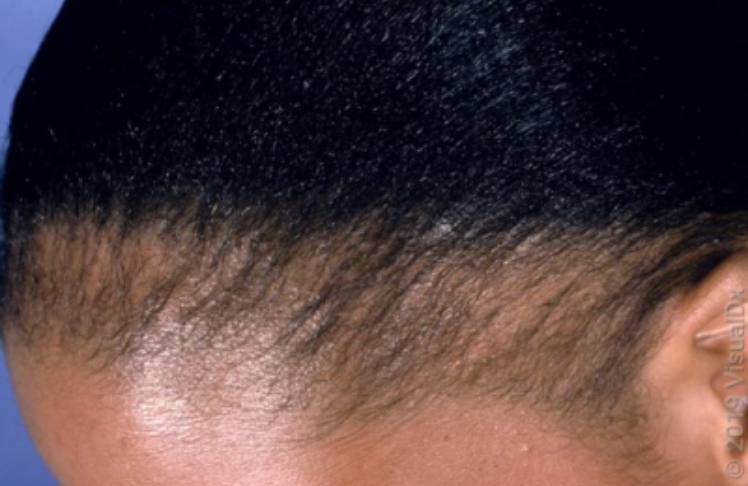
by Alexa Spencer
In a time when culture is raving about natural hair and lawmakers are making it illegal to discriminate against it in the workplace, what’s causing so many Black women to have alopecia?
Dr. Danita Peoples-Peterson, a dermatologist practicing in Midland, Michigan, says it has a lot to do with the choice of hairstyle, but there are other reasons too.
“Alopecia is just a medical word that describes hair loss,” she says.
There are several types of alopecia, but traction alopecia is the most common to affect Black women. The condition is caused by wearing tight hairstyles, using heat, and applying chemicals. One-third of women of African descent who wear these “traumatic hairstyles” are affected by the condition.
Peoples-Peterson says wearing tight weaves and extensions or styles that pull the hair back at the edges, like high ponytails, can play a role in hair loss.
“The main thing that happens to us, Black women, as far as traction alopecia is concerned, is the continued application of heat, especially to the edges — the front edges,” she told Word In Black in a phone interview. “And wearing your hair in really tight braids.”
Peoples-Peterson encourages Black women to be sure the “protective styles” they choose actually protect their hair. For example, she recommends exploring other options, like crochet braids, rather than going with individual braids or plaits.
“You would cornrow your hair and then just crochet the extra hair on top and leave it like that,” she says. “And in that state, you wouldn’t have to put heat on it all the time or chemicals.”
Wigs also made the cut because they don’t cause tension or require heat.
More Black Women Are Wearing Their Natural Hair
While some of the no-no styles Peoples-Peterson mentioned are still popular, the Wayne State University professor believes things are turning around, and the Black community is embracing natural, healthy hair.
“Maybe there’s less social pressure to wear your hair straight. And as a consequence, there’s less hair breakage, less scarring alopecia, less traction alopecia,” she says.
And contrary to the belief that Black hair doesn’t grow, she says embracing natural hair can help the hair “attain a longer length too.”
According to a 2018 Mintel report on the Black haircare market, 40% of Black women reported they were most likely to wear their hair with no chemicals or added heat. And 33% said they’d wear their natural hair, but with added heat.
The report also noted that hair relaxer sales have dropped by 22.7% since 2016.
Things were different when Peoples-Peterson was a kid. She recalls suffering from traction alopecia at age 2 and being discouraged from wearing her natural hair at home and school.
On top of being expected to straighten her hair, there were times when her family told her that she didn’t have “good hair.”
By the time she was in high school and college in the 70s and 80s, she was rocking her hair in an afro or short haircut.
Now, she encourages parents to “say things that will make [their children] feel more confident about how their hair looks in a natural state,” so they won’t feel unattractive.
And for Black adults, she encourages them to accept themselves as they are “because then, you wouldn’t feel obligated to do as much traumatic or damaging things to your hair or scalp.”
How Lawmakers Are Advocating for Natural Hair, Alopecia Rights
Fortunately for children and adults today, support for natural hair has also made it to the lawbooks.
The passing of the CROWN Act (Creating a Respectful and Open World for Natural Hair) made it illegal to discriminate against race-based hairstyles in the workplace and public schools.
The bill hasn’t been federally adopted, but several states have picked it up. Among them are California, New York, Oregon, and New Jersey.
Most recently, Massachusets — the home of congresswoman and alopecia advocate Ayanna Pressley (D-MA) — signed the bill into law.
In honor of Alopecia Awareness Month, Pressley recently shared her vision for the future of health for those living with alopecia.
She said on the house floor, “Thankfully, although [alopecia] does not threaten our lives, it does not mean it does not impact it.”
“Collectively, we are fighting for bold investments in skin disease research, comprehensive medical coverage, and meaningful public education to combat the stigma, discrimination, bullying, and indeed even depression and suicide ideation that so many of us experience,” Pressley said.
She’s currently advocating for wigs to be covered by Medicare for people living with alopecia or undergoing chemotherapy for cancer.
When to Seek Out Help for Hair Loss
Alopecia isn’t an experience limited to women or adults.
It can also be caused in ways other than tight hairstyles — such as changes in the immune system, not eating healthy, having a baby, experiencing menopause, and wearing sports helmets.
Peoples-Peterson says there are over-the-counter medicines to treat alopecia, such as the topical cream minoxidil.
Some of the symptoms of alopecia “that could start in the beginning would be itching, tenderness, irritation, breakage,” Peoples-Peterson says.
As a Black doctor, Peoples-Peterson recommends seeking out professionals for advice, like a natural hairstylist for initial advice and a dermatologist before the condition progresses.
“We’re familiar with the types of styling practices that we use on our hair,” she says. “And usually, if they come and get help before scarring has actually occurred, most of the time, you could restore the hair.”















